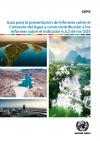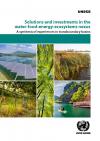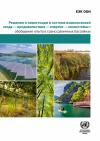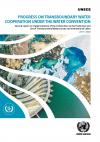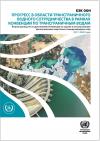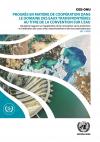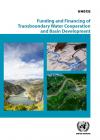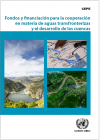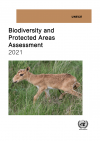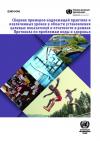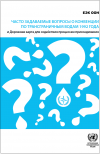Publications
Displaying Results 41 - 60 of 618
- Español
La introducción de un mecanismo de seguimiento de la aplicación del Convenio del Agua y la adopción del marco de los ODS (indicador 6.5.2 de los ODS) marcan un paso importante en el apoyo a la cooperación en materia de aguas transfronterizas. Esta Guía para la presentación de informes sobre el Convenio del Agua y como contribución a los informes sobre el indicador 6.5.2 de los ODS se elaboró como
- English
How can governments, other public and private actors learn about and better understand the water-energy-food-ecosystems nexus?
How can they use a ‘nexus approach’ to address the most pressing issues in transboundary water basins?
Last but not least, how can they design and implement ‘nexus’ solutions and investments that create synergies and provide transboundary benefits?
The new publication ‘
- Pусский
How can governments, other public and private actors learn about and better understand the water-energy-food-ecosystems nexus?
How can they use a ‘nexus approach’ to address the most pressing issues in transboundary water basins?
Last but not least, how can they design and implement ‘nexus’ solutions and investments that create synergies and provide transboundary benefits?
The new publication ‘
- Français
Comment les gouvernements et les autres acteurs publics et privés peuvent-ils apprendre et mieux comprendre le lien eau-énergie-alimentation-écosystèmes?
Comment peuvent-ils utiliser une "approche nexus" pour traiter les problèmes les plus urgents dans les bassins hydrographiques transfrontières?
Enfin, et surtout, comment peuvent-ils concevoir et mettre en œuvre des solutions et des
- English
The Convention on the Protection and Use of Transboundary Watercourses and International Lakes (Water Convention), hosted by the United Nations Economic Commission for Europe (ECE), requires Parties to prevent, control and reduce transboundary impact, use transboundary waters in a reasonable and equitable way and cooperate to ensure their sustainable management. Parties bordering the same
- Pусский
The Convention on the Protection and Use of Transboundary Watercourses and International Lakes (Water Convention), hosted by the United Nations Economic Commission for Europe (ECE), requires Parties to prevent, control and reduce transboundary impact, use transboundary waters in a reasonable and equitable way and cooperate to ensure their sustainable management. Parties bordering the same
- Français
La Convention sur la protection et l’utilisation des cours d’eau transfrontières et des lacs internationaux (Convention sur l’eau), dont le secrétariat est assuré par la Commission économique des Nations Unies pour l’Europe (CEE-ONU), exige des Parties qu’elles préviennent, maîtrisent et réduisent l’impact transfrontière, qu’elles utilisent les eaux transfrontières de manière raisonnable et
- English
More than 60 per cent of the world’s freshwater flow is shared between two or more riparian states. The sustainable and cooperative management of these transboundary water resources is crucial for access to water, sustainable development as well as regional stability and peace. However, many countries and basins struggle to identify and mobilize the needed funding for transboundary water
- Español
More than 60 per cent of the world’s freshwater flow is shared between two or more riparian states. The sustainable and cooperative management of these transboundary water resources is crucial for access to water, sustainable development as well as regional stability and peace. However, many countries and basins struggle to identify and mobilize the needed funding for transboundary water
- English
Most of the world’s water resources are shared between countries. These transboundary waters create social, economic, environmental and political interdependencies that make cooperation a precondition to sustainable development and peace. SDG indicator 6.5.2 measures cooperation on both transboundary river and lake basins, and transboundary aquifers. In this second report on SDG indicator 6.5.2,
- العربية
Most of the world’s water resources are shared between countries. These transboundary waters create social, economic, environmental and political interdependencies that make cooperation a precondition to sustainable development and peace. SDG indicator 6.5.2 measures cooperation on both transboundary river and lake basins, and transboundary aquifers. In this second report on SDG indicator 6.5.2,
- Pусский
Most of the world’s water resources are shared between countries. These transboundary waters create social, economic, environmental and political interdependencies that make cooperation a precondition to sustainable development and peace. SDG indicator 6.5.2 measures cooperation on both transboundary river and lake basins, and transboundary aquifers. In this second report on SDG indicator 6.5.2,
- Français
La majorité des ressources mondiales en eau sont partagées entre les pays. Ces eaux transfrontières créent des interdépendances sociales, économiques, environnementales et politiques qui font de la coopération une condition préalable au développement durable et à la consolidation de la paix. L’indicateur 6.5.2 des ODD mesure la coopération relative aux bassins hydrographiques et aux aquifères
- Español
La mayoría de los recursos hídricos del mundo son compartidos entre varios países. Las aguas transfronterizas generan interdependencias políticas, sociales, económicas y ambientales que hacen de la cooperación en materia de aguas transfronterizas una condición previa para el desarrollo sostenible y la paz. Mediante el indicador 6.5.2 de los ODS se mide la cooperación transfronteriza tanto en las
- English
This assessment was conducted between 18 June 2020 and 3 June 2021 with the objective of analysing the developments and challenges in the management of biodiversity and protected areas (PAs) in 14 countries that carried out and completed a ECE Environmental Performance Review (EPR) under its 3rd cycle (further 3EPR) since 2014. This includes Albania (2018), Belarus (2016), Bosnia and Herzegovina
- Pусский
The objective of the Collection of good practices and lessons learned on target setting and reporting under the Protocol on Water and Health is to provide concrete advice to countries planning to embark on the process of setting, revising or implementing targets, and reporting on the progress achieved in accordance with the Protocol.
In 2010,
- English
The calendar covers selected findings on biodiversity and protected areas from 15 environmental performance reviews (EPRs) conducted in the period 2012–2020. By disseminating the results of the EPRs in the form of a calendar for the upcoming year, UNECE aims to draw attention to the findings of the reviews and encourage the implementation of the EPR recommendations in 2021 and beyond. For a
- Pусский
The present publication contains the third Environmental Performance Review of Uzbekistan. The report examines the progress made by the country in the management of its environment since it was reviewed for the second time in in 2009–2010 and assesses the implementation of the recommendations made in the second review.
The EPR covers legal and policy frameworks and environmental compliance
- English
The present publication contains the third Environmental Performance Review of Uzbekistan. The report examines the progress made by the country in the management of its environment since it was reviewed for the second time in in 2009–2010 and assesses the implementation of the recommendations made in the second review.
The EPR covers legal and policy frameworks and environmental compliance
- Pусский
Конвенция по охране и использованию трансграничных водотоков и международных озер (Конвенция по трансграничным водам) была принята в 1992 году и вступила в силу в 1996 году. В 2003 году в Конвенцию по трансграничным водам, изначально разработанную в качестве регионального документа, были внесены поправки, с тем чтобы дать возможность странам, не входящим в регион ЕЭК ООН, присоединяться к


